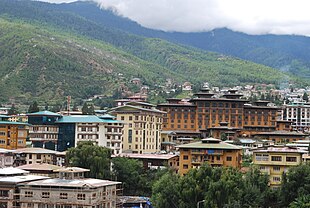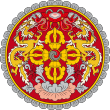Economy of Bhutan
 Thimphu is the largest economic centre of Bhutan. | |
| Currency | ngultrum (BTN) Indian rupee (INR) |
|---|---|
| 1 July – 30 June | |
Trade organizations | SAFTA |
Country group |
|
| Statistics | |
| Population | |
| GDP |
|
| GDP rank | |
GDP growth |
|
GDP per capita |
|
GDP per capita rank | |
GDP by sector |
|
| 7.35% (2021)[4] | |
Population below poverty line | |
| 37.4 medium (2017, World Bank)[7] | |
Labor force | |
Labor force by occupation |
|
| Unemployment | |
Main industries | Cement, wood products, processed fruits, alcoholic beverages, calcium carbide, tourism |
| External | |
| Exports | |
Export goods | Iron and Steel, Salt Sulphur and Cement, Aircraft |
Main export partners | |
| Imports | |
Import goods | machinery, minerals, motor vehicles, metals |
Main import partners | |
FDI stock |
|
Gross external debt | |
| Public finances | |
| −3.4% (of GDP) (2017 est.)[3] | |
| Revenues | 655.3 million (2017 est.)[3] |
| Expenses | 737.4 million (2017 est.)[3][note 1] |
| Economic aid | $985 million (India) (2015-16) |
All values, unless otherwise stated, are in US dollars. | |
The economy of Bhutan is based on agriculture and forestry, which provide the main livelihood for more than 60% of the population. Agriculture consists largely of subsistence farming and animal husbandry. Rugged mountains dominate the terrain and make the building of roads and other infrastructure difficult. Bhutan is among the richest by gross domestic product (nominal) per capita in South Asia, at $3,491 as of 2022, but it still places 153rd, and among the poorest in the world. The total gross domestic product is only $2,653 million, and 178th according to IMF.
Bhutan's economy is closely aligned with India's through strong trade and monetary links and dependence on India's financial assistance. Most production in the industrial sector is of the cottage industry type. Most development projects, such as road construction, rely on Indian migrant labour. Model education, social, and environment programs are underway with support from multilateral development organisations.
Each economic program takes into account the government's desire to protect the country's environment and cultural traditions. For example, the government, in its cautious expansion of the tourist sector, encourages visits by upscale, environmentally conscientious tourists. Detailed controls and uncertain policies in areas such as industrial licensing, trade, labour, and finance continue to hamper foreign investment. Hydropower exports to India have boosted Bhutan's overall growth, even though GDP fell in 2008 as a result of a slowdown in India, its predominant export market.
Since 1961, the government of Bhutan has guided the economy through five-year plans in order to promote economic development.[13]
On 8 December 2023, Bhutan graduated from the UN's list of least developed countries (LDCs), making it only the 7th country to do so and the first in 3 years.[14][15]
Macro-economic trend
[edit]This is a chart of trend of gross domestic product of Bhutan at market prices [1] by the International Monetary Fund:
| Year | GDP (millions of BTN) | GDP (millions of USD) |
|---|---|---|
| 1985 | 2,166 | 175 |
| 1990 | 4,877 | 279 |
| 1995 | 9,531 | 294 |
| 2000 | 20,060 | 460 |
| 2005 | 36,915 | 828 |
| 2008 | 45,000 | 1280 |
| 2011 | 84,950 | 1695 |
| 2014 | 119,546 | 1784 |
| 2017 | 159,572 | 2294 |
Bhutan's hydropower potential and its attraction for tourists are key resources. The Bhutanese Government has made some progress in expanding the nation's productive base and improving social welfare.
In 2010, Bhutan became the first country in the world to ban smoking and the selling of tobacco. In order to stamp out cross-border smuggling during the pandemic, a new Tobacco Control Rules and Regulations (TCRR) 2021 allowed the import, sales and consumption of tobacco products.[16]
Membership of economic organizations and agreements
[edit]In terms of trade, Bhutan is a member of the South Asian Free Trade Area (SAFTA) and the Bay of Bengal Initiative for Multi-Sectoral Technical and Economic Cooperation (BIMSTEC) and the South Asia Subregional Economic Cooperation (SASEC).[17][18][19] Bhutan is also a member of the pan-Asian Asia Cooperation Dialogue (ACD), and the Asian Development Bank.[20][21]
Bhutan first applied to join the WTO in 1999 and as an applicant, was quickly granted observer status[22] Beyond that, ascension proceedings at the WTO have been much delayed and periodically put on pause, largely stemming from concerns and considerations of the Bhutanese government itself.[22][23][24][25] The Bhutanese government approved ascension to the WTO in April 2023, at least partly hastened by the country's upcoming graduation from the UN-defined 'least developed country (LDC) category.[26][27] Under WTO rules and processes, ascent of a country with LDC status comes with some leniency in certain requirements, more relaxed timeframes for compliance, and additional support;[28] so, whilst the loss of LDC status, as happened in December 2023, was a reflection of Bhutan's success and development progress, it also meant much further delay in WTO ascension (that is, ascent after the loss of LDC status) would make the journey through to full WTO member status even harder.[24][26][29]
GNH versus GDP
[edit]In the 1970s the King placed Gross National Happiness over Gross Domestic Product.[30][31]
See also
[edit]- Agriculture in Bhutan
- Banking in Bhutan
- Mining in Bhutan
- Fishing in Bhutan
- Forestry in Bhutan
- Bhutanese ngultrum, currency
References
[edit]- Notes
- ^ the Government of India finances nearly one-quarter of Bhutan's budget expenditures
- Public domain
 This article incorporates public domain material from The World Factbook. CIA.
This article incorporates public domain material from The World Factbook. CIA. This article incorporates public domain material from U.S. Bilateral Relations Fact Sheets. United States Department of State.
This article incorporates public domain material from U.S. Bilateral Relations Fact Sheets. United States Department of State.
- Citations
- ^ "World Economic Outlook Database, April 2019". International Monetary Fund. Retrieved 29 September 2019.
- ^ "World Bank Country and Lending Groups". World Bank. Retrieved 29 September 2019.
- ^ a b c d e f g h i j k "The World Factbook". Central Intelligence Agency. Retrieved 25 January 2019.
- ^ "World Economic Outlook Database, October 2019". International Monetary Fund. Retrieved 20 October 2019.
- ^ "Poverty headcount ratio at national poverty lines (% of population) – Bhutan". World Bank. Retrieved 21 March 2020.
- ^ South Asia Economic Focus, Spring 2020 : The Cursed Blessing of Public Banks. World Bank. 12 April 2020. p. 92. ISBN 978-1-4648-1566-9. Retrieved 14 April 2020.
- ^ "GINI index (World Bank estimate)". World Bank. Retrieved 25 January 2019.
- ^ "Human Development Index (HDI)". hdr.undp.org. HDRO (Human Development Report Office) United Nations Development Programme. Archived from the original on 14 August 2019. Retrieved 8 September 2022.
- ^ "Inequality-adjusted HDI (IHDI)". hdr.undp.org. UNDP. Retrieved 22 May 2020.
- ^ "Labour force, total – Bhutan". World Bank. Retrieved 5 March 2020.
- ^ "Employment to population ratio, 15+, total (%) (national estimate) – Bhutan". World Bank. Retrieved 5 March 2020.
- ^ a b c d "Bhutan (BTN) Exports, Imports, and Trade Partners".
- ^ "1961 – First Five-Year Plan launched". Bhutan 2008. Archived from the original on 25 August 2011. Retrieved 22 August 2011.
- ^ "UN list of least developed countries | UNCTAD".
- ^ "How Bhutan graduated from the 'Least Developed Country' status". 12 March 2023.
- ^ "Selling and buying of tobacco products are no longer illegal in Bhutan". DailyBhutan. Retrieved 6 December 2021.
- ^ Penjore, D (2004). "Security of Bhutan: walking between the giants" (PDF). Journal of Bhutan Studies. 10: 108–131 – via Cambridge University Press.
- ^ "Bhutan | International Investment Agreements Navigator | UNCTAD Investment Policy Hub". investmentpolicy.unctad.org. Retrieved 1 May 2024.
- ^ "South Asian Free Trade Area (SAFTA) | LDC Portal – International Support Measures for Least Developed Countries". United Nations. Retrieved 29 April 2024.
- ^ "Asia Cooperation Dialogue". acd-dialogue.org. Retrieved 29 April 2024.
- ^ Asian Development Bank (12 July 2023). "Bhutan and ADB". Asian Development Bank. Retrieved 1 May 2024.
- ^ a b "Bhutan's Long Journey into the World Trade Organization". thediplomat.com. Retrieved 1 May 2024.
- ^ "Govt says no to WTO for now". The Bhutanese. Retrieved 2 May 2024.
- ^ a b Wangchuk, Karma Tshering (9 March 2021). "Bhutan and India's Free Trade Agreement (FTA) and the World Trade Organization (WTO): A Critical Appraisal". Rig Tshoel – Research Journal of the Royal Thimphu College. 4 (1).
- ^ Mancall, Mark (2003). "Bhutan's Quadrilemma: To Join Or Not To Join The WTO, That Is The Question" (PDF). Journal of Bhutan Studies. 9 (5) – via Digital Himalaya.
- ^ a b "Opinions vary as Bhutan's graduation from LDC Status amid joining WTO". The Bhutanese. Retrieved 1 May 2024.
- ^ "Graduation of countries from the least developed country category; Resolution adopted by the General Assembly on 13 December 2018" (PDF). United Nations. 13 December 2018. Retrieved 1 May 2024.
- ^ "World Trade Organization (WTO ) | LDC Portal – International Support Measures for Least Developed Countries". United Nations. Retrieved 2 May 2024.
- ^ "Bhutan graduates from LDC status | Department of Economic and Social Affairs". United Nations. Retrieved 1 May 2024.
- ^ Sharma, Lyonpo Loknath (25 October 2021). "What Bhutan got right about happiness – and what other countries can learn". World Economic Forum. Retrieved 27 February 2022.
- ^ "Bhutan's Gross National Happiness Index". Oxford Poverty & Human Development Initiative (OPHI). University of Oxford. Retrieved 27 February 2022.
Further reading
[edit]- "The Economic Contribution of Copyright-Based Industries in Bhutan" (PDF). Intellectual Property Division, Ministry of Economic Affairs. Royal Government of Bhutan. October 2011. Archived (PDF) from the original on 4 June 2013.
- "Economic Development Policy" (PDF). Royal Government of Bhutan. December 2016. Archived (PDF) from the original on 9 October 2022.
- Shah, Sukhdev (1989). "Developing Bhutan's Economy: Limited Options, Sensible Choices". Asian Survey. 29 (8): 816–831. doi:10.2307/2644628. ISSN 0004-4687. JSTOR 2644628.
- Nayak, Sohini (7 February 2022). "The Bhutanese economic revival". ORF.
- Ranjan, Amit (17 February 2020). "Structural Transformation of Bhutan's Economy: Challenges Remain". National University of Singapore (NUS) Institute of South Asian Studies (ISAS).
External links
[edit]- Global Economic Prospects: Growth Prospects for South Asia The World Bank, 13 December 2006

